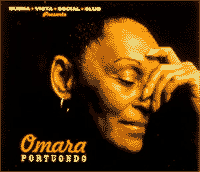
OMARA PORTUONDO
BUENA VISTA CLUB PRESENTS OMARA PORTUONDO (World Circuit/Nonesuch)
I was so repelled by the hype around the Buena Vista Social Club that I didn't check out Omara Portuondo's solo album, and now that I have I must be contrite. It's a superb example of old style Cuban big band music with fine arrangements and great singing by the liveliest of the geriatric crew who make up this "Stars on 45" of boleros. Fans of Graciela, who fronted Machito's band, or Maria T. Vera, who died in 1965 but even then was known as "the ambassador of the popular tunes of yesteryear," will enjoy it. In fact, Portuondo performs three songs associated with Vera: "He pertido contigo," "Ella y yo," and Vera's own habañera, "Veinte años." Back then, Portuondo was making her mark in the Cuarteto d'Aida who created a new romantic sound known as "film" style. But it's to the era before Vera -- the forties -- that this album returns for its style. The sound of Beny More's mambo "Donde estabas tù?" comes replete with a big horn section. We have to visualize the floor show by the Tropicana dancers that went with this. The musicianship is superb and there is a complete string orchestra in addition to the stellar line-up including Papi Oviedo on tres, Mirabel on trumpet, and Ruben Gonzalez on piano.
The muted trumpet and piano are to the fore on "No me vayas a engañar," a simple, short and gentle bolero that again brings in a big horn section reminiscent of Beny More's Banda Gigante.
By now the works of the great Cuban composers like Ernesto Lecuona and Miguel Matamoros are becoming as familiar as American standards by Cole Porter and George Gershwin. Gershwin knew Cuban music and even appropriated Lecuona's melodies for his Cuban Overture in 1932. Portuondo does "The Man I Love," now rewritten as a song of loss, instead one of anticipation. For a change of pace there's Arsenio's Rodriguez's "No me llores mas," a duet with Ibrahim Ferrer (who won the Grammy as the best new Latin artist, though he sounds like he's ready to give up the ghost). I prefer the version by Sierra Maestra on DUNDUNBANZA! -- the album that in some ways led to the BV Socialite Phenomenon. Portuondo's version sounds too eager for a reconciliation. The band pours on the shmalz on "Veinte años." The whole album exudes dreaminess and a return to a lost Cuba. If you like to wallow in it, this is the album for you.
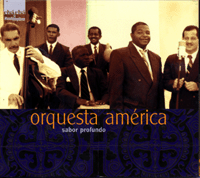
ORQUESTA AMERICA
SABOR PROFUNDO (RealRhythm)
Orquesta America SABOR PROFUNDO is the latest from a band that was founded 50 years ago in Havana. That was when Enrique Jorrin launched the Cha Cha Cha craze with his hit "La Enganadora." Like the title suggests, there is a deep richness to the selections here which cover mambo, various types of son, cha-cha-cha and guaracha. The line-up is classic charanga which is a big band with strings but no brass. There is a wooden flute prominent in the melody, coasting on the strings, and a swinging rhythm section anchored by bajo and piano. You can hear how the sound evolved from the danzón in the formal courtly introductions to each piece before the flute starts to jam and everyone lifts the tempo a notch. There is also a medley of sones to show the treatment accorded those famous riffs by a bigger band. This is a sweet and swinging album full of classic charanga: what more could you want?
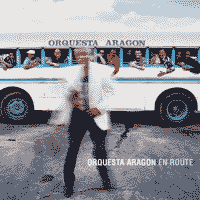
ORQUESTA ARAGON
EN ROUTE Harmonia Mundi; World Village)
The venerated Orquesta Aragon from Cuba toured the USA twice in 2001 and really tore the place up. Their latest release EN ROUTE was recorded in summer 2001 in Paris. It's presented as a career retrospective without being a greatest hits package. It includes sorties into rock and roll and sucu sucu as well as their more familiar charanga sound leaning heavily on their virtuosi on violin and flute. Aragon started in 1939 as a danzonete but evolved to include mambos and caught on to the cha-cha sound as soon as it was pioneered by Enrique Jorrin and his Orquesta America. In fact Jorrin gave them charts to copy. After the revolution they became even more popular though they were occasionally criticized for singing old songs that described bourgeois lifestyles! Their hits, like "Pare Cochero," "El Paso del Encarnacion" and the classic danzón "La Reina Isabel" are absent. There's a rap song and the accidentally funny "La Gioconda," which anyone in the Western world knows as Alan Sherman's "Hello mudda, hello fadda!" Perennial favourites like "Siboney" or "Bruca Manigua" are also omitted, but this is a band with a staggering repertoire. Back in the 60s they covered "Yaye boy" by Africando, Franklin Boukaka's "Le Boucheron" and even did a cover of Los Bravos' "Black is Black." There is little sign of the easy-listening, lounge side of their repertoire (from Saint-Saens to Tom Jones' "Delilah") but that is the fun of a band that has evolved over 60 years: there is plenty more to find. Indeed this is a fine introduction to a tight orchestra that still swings.
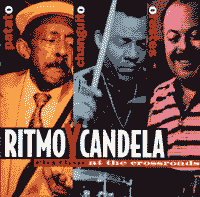
PATATO, CHANGUITO, ORESTES
RITMO Y CANDELA/RHYTHMS AT THE CROSSROADS (Redwood Records RR9503CD 1995)
A rare opportunity to get three of Cuban music's hottest percussionists in one room occurred in San Francisco in 1994 during the Encuentro del Canto Popular. Some outstanding local talent added jazzy fills to the funky descarga (jam session) created by Patato on congas and Changuito on bongos, while Orestes Vilató, on timbales, added rhythmic thunder. This album covers a lot of ground. "Guiro para Ogun" is a traditional Afro-Cuban incantation. The dreamy "Calipso en las Nubes" features steel drums while "Yo tengo Ritmo" has jazzy baritone sax breaks. The moody "Desde el fondo del Rio" starts out like "Riders on the Storm" on electric piano and coalesces into a reverie of the many directions possible within the improvisational framework of Afro-Cuban music. You say potato, I say "Buy this Grammy-nominated record!"

ROUGH GUIDE BOOK & CD:
CUBAN MUSIC STORY (Rough Guide RGNET 1068 CD)
A different approach is taken by THE ROUGH GUIDE TO CUBAN MUSIC. First there's a book by Philip Sweeney: a pocket-size, illustrated 350-page guide to the music which, despite it's apparent size, is a quick once-over of the highlights of the story of this complex engrossing musical culture. Then there's the CD titled CUBAN MUSIC STORY compiled by David Flower which is a different, equally personal take on the story with a couple of nods to the classics (it opens with Beny More and closes with a cornball lounge piece by Peruchin) but mostly hits on recent successes (Afro-Cuban All Stars, ¡Cubanismo!). There are a couple of less-than-stellar cuts (Azucar Letal, the Zap Mama of Cuba), and no Arsenio Rodriguez, Cachao, Septeto Nacional or Trio Matamoros, but that's one we could argue all night. To do it right would take at least a 4-CD set. The compiler's justification for leaving out much historic material was the sonic quality. Instead he has focussed (a little too narrowly I think) on recent dancefloor hits. The Buena Vista Lite touch suggests this one is for neophytes.
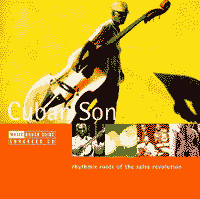
VARIOUS ARTISTS
THE ROUGH GUIDE TO CUBAN SON (Rough Guide RGNET 19)
THE ROUGH GUIDE TO CUBAN SON from World Music Network strolls down one of my favorite memory lanes. From the wealth of material available, the compiler, Phil Stanton, has chosen the biggest hits by the most famous names. One of the oldest Son groups is Septeto Nacional de Ignacio Pineiro, but here they are represented from their 1998 album, SONEROS DE CUBA. I thought the sequel MAS CUBAS LIBRES was better, but their "En Guantanamo" shows the classic form of the Son with tres and a solo trumpet and the clavé 3+2 beat that became the basis of salsa. Right after this we are slapped with the fat sound of Afro-Cuban All Stars performing Lili Martinez's "Alto Songo" and there's no mistaking Ry Cooder, since they namecheck him. Too bad his slide guitar contributes nothing to the sound. I wish Juan de Marcos the arranger would stop being so modest and play the tres solo himself and let Cooder practice his Spanish instead. Vieja Trova Santiaguera gives us a sweet rendering of Miguel Matamoros' "El Tren," complete with mouth percussion and whistling instead of a trumpet. My favourite version of this is by Barbarito Torres who is absent from the present compilation. But there's no argument with Orchestre Sierra Maestra's "Chango Ta Veni," one of the classics of the revitalized son. The big sound is spearheaded by Juan de Marcos on tres and the bright trumpet of Jesus Alemany, who later formed Cubanismo. The composer himself, Nico Saquito, gives us his "Maria Cristina." Now we get to hear some rocking geriatrics. Another classic is Maria Teresa Vera's "Eso no es na," accompanied by Lorenzo Hierrezuelo. "Chan Chan" is given a delicate touch by the Familia Valera Miranda. This is a song that is approaching "Peanut Vendor" status in the canon of popular Cuban recordings. It's right behind "Lagrimas Negras" & "Son de la Loma" as perilously close to the overdose zone. The album ends with the slamming Los Jubilados, yet another gang of oldtimers who got together to reignite the flame of their youth in this wonderful sound. For beginners this CD is a great introduction; for the jaded types who've heard it all, it is still well-sequenced and saves you having to jump up and play deejay when you want an hour of great Cuban music.
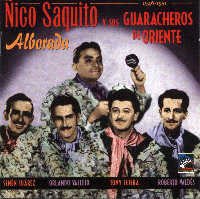
ÑICO SAQUITO Y SUS GUARACHEROS DE ORIENTE
ALBORADA (Tumbao TCD-094)
It's a while since I jumped on any new Cuban releases, but I keep my eyes peeled for interesting reissues of the good stuff. Ñico Saquito became well-known at the end of his life, performing at the Bodeguita del Medio, the Cajon de Bateo, and the Casa de la Trova in Santiago, accompanied by Cuarteto Patria, the Conjunto Oriental de Bimbi, or El Duo Cubano. He wrote some fabulous songs, which were widely covered, including "Chencha la Gamba," "Maria Cristina," "A la orilla del Cauto" and "Al vaiven de mi carreta." He was something of a snappy dresser and remained a star to the end. Saquito which means "little sack" was a nickname from his youth when he was so good at baseball people would say he was like a little sack for catching balls. After working as a smelter, he started out as a radio station music arranger, but soon got himself a spot on the airwaves with a band fronted by Orlando Vallejo, a talented singer, who abandoned a succesful career in Cuba to try his luck in the USA and died in misery. Saquito's early recordings, from 1946 to 1951 are collected on this wonderful disc. In addition to guarachas, for which he is best known, there are son montunos and boleros, so a nice blend of styles. He wrote in many styles including "rural" or Cuban country music & in the 1950s, while living in Venezuela, wrote songs in support of Fidel and the Revolution which earns him credit as the first Cuban protest singer. The 1947-51 recordings presented here are truly noteworthy, with piano in the mix, "laughing" trumpet, sporty bongos, and stately vocals by Alfredito Valdez and Ramon Veloz who sings and plays piano on the peak of the album: the consummate rendering of "Al vaiven de mi carreta."
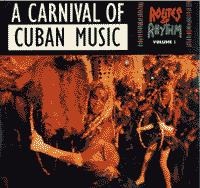
VARIOUS ARTISTS
A CARNIVAL OF CUBAN MUSIC: ROUTES OF RHYTHM VOL 1 (Rounder 5049)
This record accompanies a PBS documentary which featured clips from American movies and television showing the impact of Cuban music on our culture. It's structurally similar to the KONBIT compilation which introduced Haitian music in 1989. The two main complaints I've heard about the record are that it's poorly recorded and that it doesn't work apart from the video. To me it sounds fine, and I had the record before I saw the show, which had some shortcomings. The section on Africa was so brief we never really understood what the connection was. There was a side trip to Spain with footage of singers in an Andalusian field and lots of clips of Harry Belafonte dancing with the locals in Havana, rubbing his nose and sniffing, and trying to appear with it. If you're hip you probably already have the tracks by Irakere or Chano Pozo and poopoo the record because it has Bing Crosby doing "Siboney" and a version of "Guantanamera." But both tracks are essential to understanding the development of Cuban popular music: "Guantanamera" is the most popular bolero-son ever recorded and is a link to the Spanish troubadour tradition, whereas Bing Crosby was just a starched front for the Xavier Cugat orchestra. The whole gamut of Cuban music is put in perspective from the introductory "Chant to Elgua," the beautiful original version of "The Peanut Vendor," which launched the rumba craze in America, to the moving "Buscando America" by Ruben Blades. The inclusion of the "rumba originals," Los Muñequitos de Matanzas, a percussion and vocal ensemble, prompted me to buy their fine album CANTAR MARAVILLOSO on Globestyle. For me however the supreme discovery of the year is Celia Cruz's live version of "Bemba Colora" on this album. Her call and response with Tito Puente's orchestra is fabulous, the whole has an erotically-charged salsa throb to it with a shrieking soprano sax that sounds closer to the Joujouka tribesmen of Morocco than jazz.
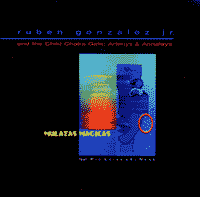
RUBEN GONZALEZ JR
MULATAS MAGICAS (Pimienta Records 245 360 590-2)
Despite embargos, restrictions and the lack of instruments, Cuba still produces the finest jazz pianists in the world. The debut Ruben Gonzalez Junior CD is a great example of a mellow album you can put on and have in the background or listen to attentively. Either way it works. The first two tracks, with up-and-coming female singers the Chiki Chaka Girls, are a bit too laid back, but by track three things start to blaze after a fuliginous start. I am all ears when Ruben Junior carves out a piano solo that does his old man credit. Latterly Ruben Senior was in the Afro-Cuban All Stars while Junior has been working as a session player, so this is his first solo album. But it is every bit as assured as if he had a dozen albums under his belt. Of course he has the likes of Miguel Cruz on percussion, Adalberto Lara on trumpet, and Juan Pablo Torres on trombone, so he is hardly going to make a flop. Torres also serves as bandleader. By track five "Dulce coco," they are in rip-it-up mode, but it ends too soon. Then we get a dreamy lounge piece to make us feel sophisticated while we mix a Cuba Libre. Vocalists include the hot young star El Nene and the grand old man of son montuno Pio Leyva. There are no writing credits but the songs are familiar, including the chestnut "Marieta" (by El Guayabero), which they tear up with El Nene on vocals, and a tribute to "Pio Pio Pa," with the great man himself growling lead. Apart from the Chiki Chaka Girls -- and their mother (!), who seem a bit overhyped, this is a superb album.
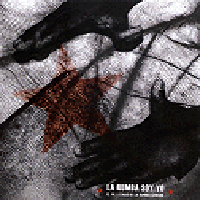
VARIOUS ARTISTS
LA RUMBA SOY YO (BIS music)
Unless you are a serious student of rumba it's a little hard to take a whole album of drumming and chanting. Yes, there are exceptions: Los Papines, Los Muñequitos de Matanzas, Grupo Yoruba Andabo, but they are just three of the best rumba groups from Cuba and to appreciate them you really have to see them in concert with the stark white costumes, tentative opening dance steps, and trance-like involvement in the music. If you are a deejay, a real rumba is a great way to ground a set of Cuban music, but most of us need a bit of variety to heighten the contrast between a full band and the stripped-down sound of just congas & acapella vocals. That's why a new album from BIS music makes so much sense. LA RUMBA SOY YO takes pure rumba and augments it with electrified dance music from Cuba to present a tapestry of all the musical styles that evolved out of this pure form. For all popular Cuban music, from Xavier Cugat and Machin eighty years ago to jazz and pop groups like Irakere, NG la Banda and los Van Van today are rooted in rumba. The cuts on this compilation range from solo conga by Tata Guines or solo guitar by Alejandro Valdes to large electric bands with brass blaring over steaming percussion sections. "Sobre una tumba una rumba" by Ignacio Piñeiro is given a fresh workout by a big band fronted by Haila on vocals. Another outstanding track is "Un violon pa' Chano" which features a busy violin solo by Lazaro Dagoberto Gonzalez that is part Paganini and part palm court orchestra (the acoustic forerunner to lounge). Then we return to the unadorned rumba tracks and our brains fill in the orchestration around the vocals and drumming. It's a satisfactory approach and makes for a very listenable set.
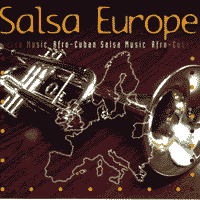
VARIOUS EUROPEANS
SALSA EUROPE (Candela)
This latest entry into the Salsa Mundo series focuses on European acts and is a strong entry. Of course Europe had the same "Son Fever" as the US starting in the 1930s, fostered by Hollywood movies, and broadened by touring bands. In addition many Cuban musicians moved to Europe to work and play. Don Gonzalo, Bebo Valdez, Sabu Martinez and many others went to play and stayed, and while the USA was undergoing its foolish embargo for the last 40 years, Europeans have had the run of the island and continued to bring the best salsa acts on tour. The album kicks off with a slamming charanga by Salsa Celtica; it is not at all odd to hear the violin lead being taken by bagpipes, in fact it works great. Amsterdam's Paradis are totally in the pocket as bandleader Ilvio Pieterz chops out a classic piano solo. You can figure out the influences: Big band Machito sound from Finland, intimate Arsenio-style conjunto and jazzy Charlie Palmieri licks in the UK, the Tito Puente showband style in France. I'd only heard of one of the acts on here, Oscar & Co from France. The other dozen are even more impressive in their chops and dedication to the salsa idiom. This one cooks.
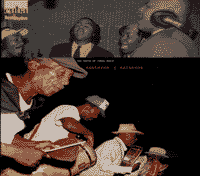
VARIOUS CUBANS
SANTEROS & SALSEROS (Real Rhythms)
A rare approach is taken for SANTEROS & SALSEROS. This CD has almost nobody you've heard of, however it still delivers first-rate Cuban music. It's on the Real Rhythm label and has been reissued by COD music of Switzerland. It presents, in sequence, examples of Santeria, Rumba, Danzón, Bolero, Campesina music, Son, Mambo, Cha-cha-cha, Son Montuno, Balada, Salsa and Conga. Some of the tunes are familiar but the groups aren't, with the exception of Septeto Nacional. Thus we get to hear these Cuban tunes as they are performed by traditional musicians who are not revising it in light of foreign relations. Hermanos Izquierdo are a family orchestra founded in 1946 who contributed substantially to the development of the Danzón and Cha-cha-cha; their version of Enrique Jorrin's "Osiris" is really fine. If like me you already have two dozen anthologies of Cuban music, you probably don't need this one. If you would like a short course in the many distinct forms of Cuban music, this is a good place to start. If you want some heavy reading matter to go along with your mini-course, then get the Piranha book and CD FROM AFROCUBAN MUSIC TO SALSA by Dr Olavo Alén Rodriguez instead.
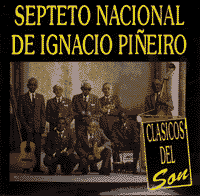
SEPTETO NACIONAL
CLASICOS DEL SON (EGREM CD 0071 1994)
The great legacy of Cuban music is in wonderful songs, fine lyrics, exquisite harmonies, superb arrangements -- whether for two guitars and bongo, or a sextet adding double bass and guiro, or a septet with a trumpeter and clavé. As this style evolved at a leisurely pace over the course of the twentieth century, many groups such as Trio Matamoros and Septeto Nacional came to it and added to the style we know as Son. While son is one of the most influential musical forms to come from Cuba, it is not as familiar as the rumba, mambo, or cha cha, which evolved from it. It starts from simple guitar riffs backed by percussion, but most of the melodic weight is carried by raspy vocals, which add charm to the music; occasionally a trumpet adds to the mix of ragged voices. All of these discrete components blend to create one of the most memorable, intoxicating sounds on the planet. This 1994 recording from the tireless Septeto Nacional of Ignacio Piñero on the Cuban national label, Egrem, comes via Canada. Going strong since the 30s, the Septeto plays stringed instruments against percussion derived from Afro-Cuban religion. The balladeering vocals share the melody with a trumpet. The son, a traditional Cuban form that preceded salsa, along with the guaguanco, bolero and rumba (other offshoots) is represented in twenty classic selections.
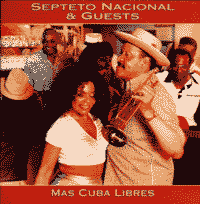
SEPTETO NACIONAL & GUESTS
MAS CUBA LIBRES (1999 Network 33 182)
While Los Teletubbies Cubanos are basking in the limelight, some of the real hardworking Cuban old-timers are still making fresh-sounding music. Septeto Nacional has a superb new recording from World Network. The title MAS CUBA LIBRES is an amusing pun on drinking and a devil-may-care comment on America's attitude about the current isolated situation of the island. They have lined up some outstanding guest stars and, frankly, it's very much in the mode of BV Social Club but unlikely to generate anything like the hoopla. The guests include Pio Leyva and Caridad Cuervo on vocals, Pancho Amat on tres, and the legendary Guillermo González "Rubalcaba" on piano. This is a really fine son album, and it would be nice if it caught on before the fickle American trendazoids decide that traditional Cuban music is just another "lambada craze" and go off in search of the next thing.
"Son is musica mulatta, a Cuban blend of European and African," wrote the great Cuban poet Nicolás Guillén. Son emerged in Santiago, on the far eastern tip of the island about a century ago when European string instruments like the guitar were added to the African percussion of bongos, maracas and claves. Both black and white Cubans accepted it and the verse form (from Spain) added the final touch to give it shape. Typically, today there is a trumpet solo to add counterpoint to the vocal melody. The addition of piano is unusual but in mulatta music, anything goes! Favourites from the founder of Septeto Nacional, Igancio Piñeiro (1888-1969), are included here, like "Coco Mai Mai" and "No Jueges con los Santos." I'm glad they added piano because Rubalcaba's solos are great, particularly on Lili Martínez' "Oye come suena" and "Uno, Dos, Tres" by Rafael Ortiz.

ORCHESTRE SIERRA MAESTRA
RUMBERO SOY (World Music Network)
Fans of Cuban Son Montuno will rejoice at the news of a new release from Orchestre Sierra Maestra. It's their best release since ¡DUNDUNBANZA! in 1994, but the departure of leader Juan de Marcos Gonzalez is noticeable. From Gonzalez' later project, the BV Social Club, Ibrahim Ferrer and Omara Portuondo show up for guest vocal spots and guitarist Marc Ribot also adds atmospheric touches to a couple of tracks. As ever the material is drawn from the classic repertoire of artists like Ñico Saquito and given a bright modern arrangement for a traditional septeto line-up. Recorded in a French chateaux the album is so comfortable and laid-back that it has lost a little of the edge that made their earlier recordings so compelling.
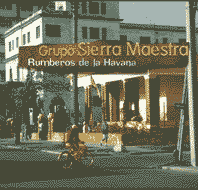
ORCHESTRE SIERRA MAESTRA
RUMBEROS DE LA HAVANA (Harmonia Mundi)
Though Ry Cooder is credited as the producer, the real genius behind the Buena Vista project was Juan de Marcos Gonzalez, the tres player and arranger. Previously, he put together Orchestra Sierra Maestra (with trumpeter Jesus Alemany), a group devoted to keeping the son of Eastern Cuba's Oriente province alive in performance. Sierra Maestra are one of my favorite bands and I feel privileged to have seen them in a local club setting (Yoshi's) instead of the concert-hall required for an act like Afro-Cuban All Stars. (I have to say that all the songs on the new Buena Vista album have been done better by other bands. Their version of "Como baila Marieta" is the hottest track on the album, but I prefer Sierra Maestra's version on their last album, TIBIRI TABARA.) Now Harmonia Mundi has reissued Sierra Maestra's RUMBEROS DE LA HAVANA from 1991, a sort of greatest hits. I say it's a greatest hits, because it serves as an introduction to Cuban musical history and includes the group's interpretations of many famous older songs, in different musical styles, from rumba to yambu to guaracha to son. Though there is no personnel listed, I'm pretty sure the brilliant trumpet playing on this recording is by Jesus Alemany who went on to found the superb Cubanismo.
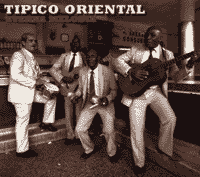
ORCHESTRE TIPICO ORIENTAL
ETERNA MELODIA (Lusafrica / BMG France)
A recent Cuban issue of note is ETERNA MELODIA by Orchestre Tipico Oriental. As their name implies, they are a classic band of soneros from Eastern Cuba, though the band moved to Havana many years ago. Originally conceived as a group to play the famous works of Miguel Matamoros, their repertoire grew and they now play the tunes of the leader Isidro Sarria Aristica. He writes classic sones, or son boleros, which have the two-part structure familiar to fans of the genre. They start with a largo where the theme is stated and move to a montuno where the jam kicks in with a chorus. There's a guitar, tres, maracas, and the quintessential Cuban instrument: bongos. The songs are pure, which means you won't hear Bonnie Raitt plunking along, and these old-timers are confident in their relaxed way, coasting through the material with that wonderful floating feeling over the rock solid clavé (I'm beginning to wonder if listening to Trio Matamoros is where Franco found the confidence to suspend the time signature in his guitar solos). There are a couple of touchstones: a melody called "Ensalada de sones" which is a potpourri of famous riffs (Miguel Matamoros' "Olvido": an original kick-out-the-jams 78 released in 1928 as the B-side of "El Que Siembra su Maiz" -- recorded in the RCA studios in Camden NJ, it sold 74,000 copies in Cuba -- "Papa Montero," and "Silencio" by Sexteto Habanero). The only song not by Aristica is vocalist Rolando Cisneros's homage to Beny Moré, which also takes a nice jagged tres solo as the outro, after extolling the talents of "el Barbara del Ritmo." The CD contains but a dozen 3-minute songs, a wonderful taste of some of the sweetest music made in the Western hemisphere. As the liner note says, "this is irresistible, authentic music, uncontaminated by the commercial virus that has debilitated so many contemporary pieces."
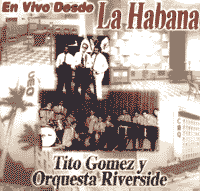
TITO GOMEZ Y ORQUESTA RIVERSIDE
EN VIVO DESDE LA HABANA (Mock & Roll, 2001)
In need of a pure salsa fix I turned to an oldie: Tito Gomez y Orquesta Riverside EN VIVO DESDE LA HABANA. A small label, Mock & Roll of Miami, has leased the music for five live albums from the golden age of Cuban big band radio, the 1950s. Of course the sound is rather thin but it's clear and well-restored and the one-dimensionality adds to the mood. The band has superb arrangements of original and covers material. They kick off with "La Engañadora" by Enrique Jorrin and "Me voy pa' New York," and also do "Red Roses for a Blue Lady," as well as other mambos. But the treats are in the occasional classical quotes from the saxes or violins and it all goes down very smoothly. Great relaxing music or background for a pleasant evening as the silken-tongued Gomez tickles your fancy. Most of the material is still part of the standard salsa repertoire so you will feel at home and maybe even be impressed by the chops of the Orquesta Riverside musicians from half a century ago. They go out steaming on a descarga of "El de la Rumba Soy Yo." It inspires me to check out the Conjunto Casino and Barbaraito Diez broadcasts included in the same series.
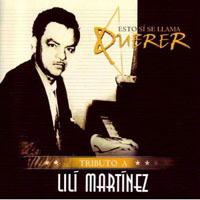
VARIOUS CUBANS
TRIBUTO A LILI MARTINEZ (Unicornio)
I don't usually write negative reviews of new releases. If it's bad I ignore it, but sometimes I feel I have to steer you away from a booby trap. Such is the case with the new TRIBUTO A LILI MARTINEZ CD on the Unicornio label which is so sleepy and loungey it's barely there. "Lili" Martínez was the pianist & arranger in Arsenio Rodriguez' conjunto and wrote some of the memorable tunes for that group, including "Sazonando," "Quimbombo," "Que se funan," "Chicharronero," and "Alto Songo." This new recording has a guest appearance by Isaac Delgado. The pianists are Miguel de Armas and Manolito Simonet; Elpidio Chappotin (son of Felix?) plays trumpet; others include El Nene and Mayito on coro and vocals. It was recorded in Havana but it's a major disappointment. Luis Martínez Griñán (1915-90) had a strong influence on later pianists like Eddie Palmieri, Frank Fernandez and Chucho Valdes. He was self-taught and started out as accompanist at a dancing academy. He came to love Chopin above all. In 1945 he joined Arsenio's conjunto (Arsenio called him "La Perle del Oriente") and five years later moved with Chappotin through a succession of bands, till his retirement due to infirmity in 1967. He later was coaxed out of retirement to play with los Ases del Ritmo. Among my favorite albums featuring Lili Martínez are Conjunto Modelo's GUAGUANCO EN LA HABANA which has three of his original compositions, and two other albums (also on the Tumbao label): MONTUNEANDO con Arsenio Rodriguez y su Conjunto and DUNDUNBANZA from the same group. Both CDs are taken from original 78s that were recorded in Havana from 1946 to 1951. There you get the full force of the incipient salsa form as it was emerging in Arsenio's line-up. Steaming versions of Lili's tunes, including "No me llores mas," "Pueblo Nuevo se paso," and "Chicharronero" can be found on these albums. So hold the Geritol, and cue up the originals.

TRIO MATAMOROS
LA CHINA EN EL RUMBA (Tumbao TCD 039)
From the early twenties to the mid-fifties, Miguel Matamoros was arguably the most popular singer in Cuba, writing and recording hundreds of songs that became international hits with simple guitar and light percussion backing. This Tumbao collection gathers two dozen trio classics in a fragrant bouquet of Boleros, Sons, and other Creole rhythms. Trio Matamoros's tight, intuitive guitar-work and unaffected, rich harmony vocals arrive full-blown in the earliest of these recordings. From the churning, propulsive beat of "Oye el Cha-cha" to the humorous ballad "Beso Discreto," punctuated with kissing sounds, a range of their material is displayed in clear, remastered sound.